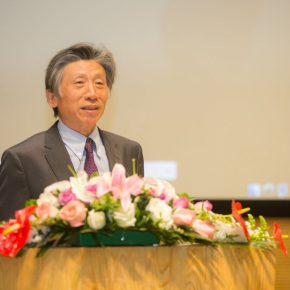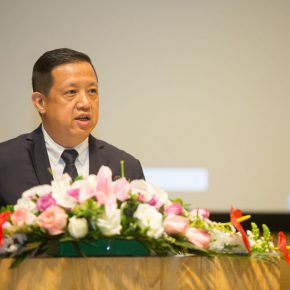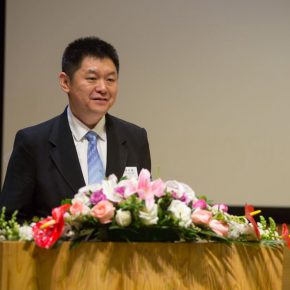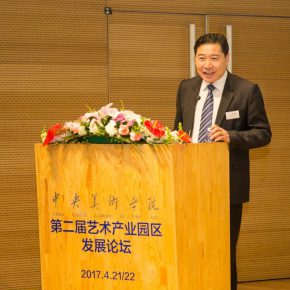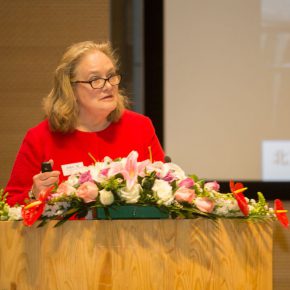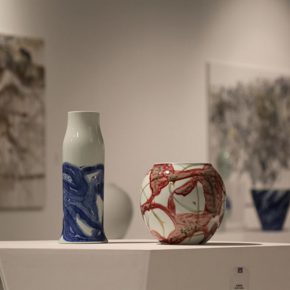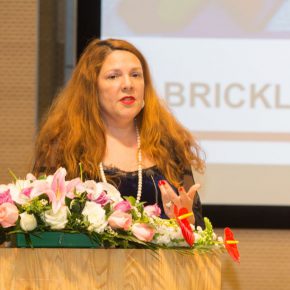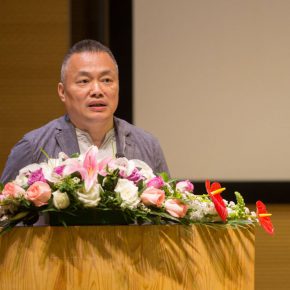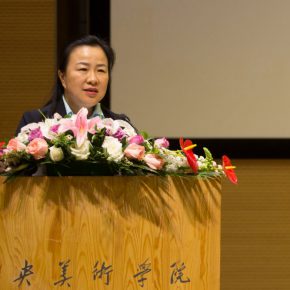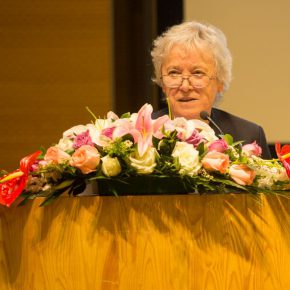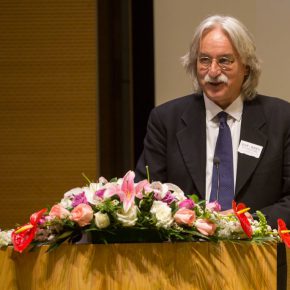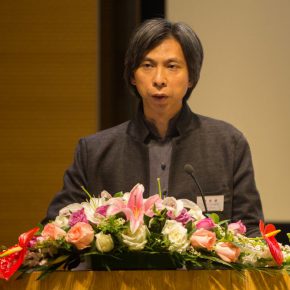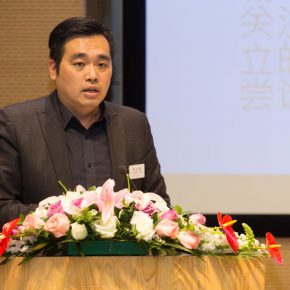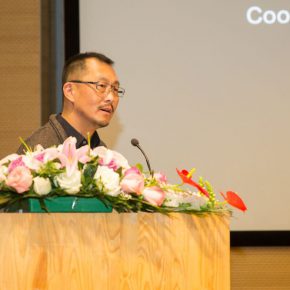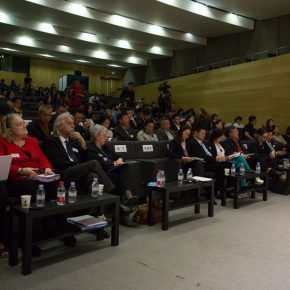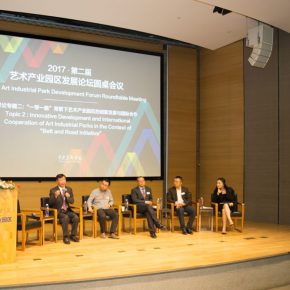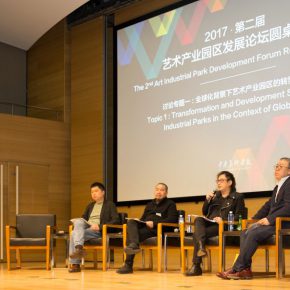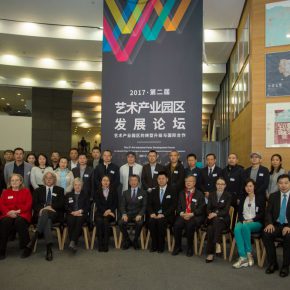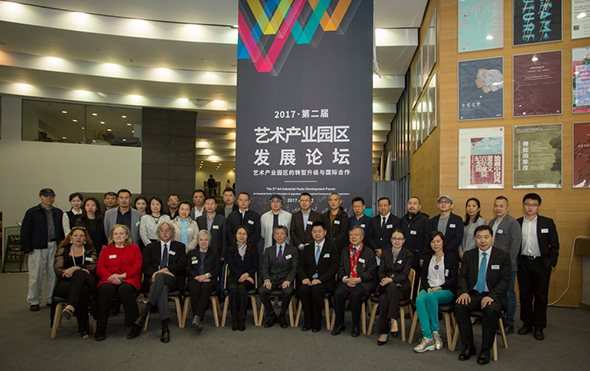
In the beginning, the industrial art parks were a place where artists and art institutions spontaneously gathered, though now it is rationally planned and invested in by the local government and enterprises so the industrial art parks have become an important part of urban development and also collectively embody a city’s artistic vitality and innovation. The Institute of Arts Administration and Education at CAFA pays great importance to the investigation and research on this topic, together with the governmental policies and the enterprises of the parks which in turn form a strong and effective academic interconnection, following “The First Industrial Art Parks Development Forum Roundtable Meeting” which was successfully held, the 2nd Industrial Art Parks Development Forum Roundtable Meeting was held in CAFA on April 21, 2017, going through to April 22. The theme of this forum is “Industrial Art Parks: Transformation & Upgrading and International Communication & Cooperation”, it gathered more than 30 builders, governmental leaders, experts and scholars from all over the world for an experimental exchange and a discussion on the programs and policies around “Transformation & Upgrading of Industrial Art Parks from An International Perspective”, “Functional Extension and International Cooperation of Industrial Art Parks”, “Transformation and Development Strategy for Industrial Art Parks in the Context of Globalization” and “Innovative Development and International Cooperation of Industrial Art Parks in the Context of ‘Belt and Road Initiative’”.
Fan Di’an, President of CAFA first delivered a speech at the opening ceremony of the forum on behalf of CAFA and he praised the broad field of vision and clear theme of this forum, which was proposed after re-examination of the construction experience and future development trend of the parks, as well as the form that combined the theoretical study and the practice & observation of the park which should achieve better results. Fan Di’an said that, the industrial art parks made great contributions to the construction of urban culture, and offered an effective interactive path for the economic, cultural and socially ecological interaction and development as well as effectively promoting the cultural exchange and cultural trade. At present, the global economy strives to move out of the doldrums, while they also see that the development of cultural industries is unstoppable. In China, green economy, rural construction and cultural self-confidence are proposed, which offers a new context for the present discussion on the transformation & upgrading and international cooperation of industrial art parks. At the same time, it is suggested that the development of the industrial art parks need rational analysis and a macro-layout while strengthening the supervision of the parks on the basis of policy support and the use of the industrial art leverage to create considerable economic benefits for society, and it also plays an important role in the promotion of urban construction, improving the urban culture and social ecology, enhancing the quality of life of the people.
The forum was unfolded in the form of key-note speech, and the honored guests combined their own research and practical experiences and shared their own results or development proposals.
Liu Junsheng, Standing Committee Member and Director of the Publicity Department of Chaoyang District in Beijing: Win-Win Development between Creative Industrial Art Parks and Cities
Chaoyang District, Beijing is one of the places that has a concentrated and mature cultural district in China. Liu Junsheng shared the key points in the construction and development of industrial parks, and the relevant strategies and suggestions, and he emphasized the 8 harmonious and win-win relationships between the park construction and urban development: firstly planning and coordinating the relationship between the development of cultural districts and industrial upgrading, the use of cultural innovation to drive the transformation and upgrading; second, planning and coordinating the relationship between the upgrading of cultural districts and the development of the innovative cluster development, the use of functional upgrading to promote the cluster development of innovation and creation; third, planning and coordinating the relationship between transformation of the cultural districts and changes in the urban flow, the use of a new format to promote the structural optimization of urban elements; fourth, planning and coordinating the relationship between the transformation of cultural districts and urban renewal, the use of cultural creativity to offer the urban renewal a path of transformation; fifth, planning and coordinating the relationship between the development of the cultural districts and urban public space, the use of the distinctive characteristics to enrich the connotation of urban space; sixth, planning and coordinating the relationship between the development of cultural districts and cultural orientation, to create a cultural atmosphere that harmoniously develops with an open and inclusive attitude; seventh, planning and coordinating the relationship between the design of the cultural districts and urban aesthetics, through cultural landscapes to add a cityscape with an humanistic temperament; eighth, planning and coordinating the relationship between the construction of cultural districts and green development, through low-carbon development to make a green ecological demonstration city.
At the same time, he also put forward four major problems to be solved in the construction and transformation and upgrading of cultural districts: to avoid disorderly development and homogeneous competition in the spatial layout and functional orientation; avoiding industrial fragmentation and refusing to blindly follow the trend, in the industrial development and brand building; avoiding the potential risks and low-end intensive industries; avoiding the absence of services and policy, in the public services and policy support.
Wang Yanling, Chairman of Beijing 798 Culture and Creative Industries Investment Co., Ltd.: 798 New Model of Transformation and Upgrading
798 Art District is the most influential industrial art park in contemporary China and even the world, Wang Yanling shared with the audience the development status of the 798 Art District in the form of data and also revealed the development orientation in the process of the transformation and upgrading: the “culture and embassy district” attracts many international cultural institutions that have now settled in; the area gathers world-class art institutions; a young artists exchange area; display and trading area for creative products; international cultural tourism area. When Wang talked about the practical problems of the development of the park, he said that the issue of tax was the first problem restricting the development of the cultural and creative industries.
Sandra Lang, Director of Visual Arts Administration MA Program and Association professor, Steinhardt School, New York University: From SoHo to the High Line, the History and Development of New York Cultural Districts
Sandra Lang shared the specific cases of the artistic development of the parks in New York: SoHo was originally the industrial area and warehouse area in New York, along with the industrial decline, and the unused warehouse spaces which were abandoned, a large number of artists and galleries settled in it in the 1960s and 1970s, and it has gradually formed a commercial aspect when the developers and shops entered in the 1980s. The High Line is different from the model of development for previous art districts, and the High Line was originally an abandoned freight rail across Manhattan, built as an unique green road with the hanging garden which has received huge social and economic benefits in the West Side of Manhattan in New York, becoming a model for international design and reconstruction of the old city. Sandra Lang also mentioned the CREATIVETIME. The majority of the cases proposed by Sandra are a new mode of operation for art districts in the United States, they are to some extent involved in the cooperation of many parts, such as government, foundations, innovative companies, and well-known artists, etc., and this cooperation breaks with previous models, and also represents the new development in this area in the United States.
Jin Weidong, Founder of Shanghai M50 Art District and General Manager of the Cultural and Creative Park at Water Street, Shaoxing, Zhejiang Province: My Two Transformations
Jin Weidong started with the work of two transformations, while his personal transformations are the two major developments and planning of cultural districts in China: Shanghai M50 Art District and the Cultural and Creative Park at Water Street, Shaoxing. M50 was diverted from the transformation of an old textile mill, practicing by the mode of proprietary trading, cutting-edge art selection, and creative market. The Cultural and Creative Park at Water Street, Shaoxing is dependent on the actual situation and its position in the culture, creation, leisure and tourism, running with the approach of “trans-border + interconnection”. The consuming of an artistic experience, creative experience and leisure experience form the win-win symbiosis, all the consumptions are implanted in the thoughts of trans-border and interconnection, offering the commercial supplement to the space project with support. Jin Weidong had a detailed description of the operational experiences of the Yueqingtang and Jianhu Art Museum.
Zhang Xinjian, Beijing Municipal Chairman of Chinese Peasants and Workers Democratic Party; Former Deputy Director-General of Culture Market Department of the Ministry of Culture: Cyclical Adjustment and Transformation Trend of Art Industrial Parks
Zhang Xinjian was the former Deputy Director-General of the Culture Market Department of the Ministry of Culture, and participated in a series of policies and programs related to the industrial art parks. He proposed that it started from the Yuanmingyuan art village to the 798 art district and Songzhuang, the industrial parks were of a certain period, while it was particularly important to deal with the relationship between the creative creation and the market. Zhang Xinjian depended on studies to give his own suggestions for a variety of featured industrial parks, for example, the industrial parks related to the design and animation that used the “double-creative” policy with the combination of both; the traditional featured art village is combined with the rural tourism and new rural construction; the districts of a low-end replication model could be combined with artificial intelligence. In addition, he also mentioned the adjustment of art districts and trends of transformation that should be combined with the internet, AR, artificial intelligence, 3D technology and other new technologies, the development of the property rights of artworks formed a comprehensive art industrial area, which was also the future trend.
Anne Gombault, Professor of management, Director of the research center Creative Industries & Culture at KEDGE Business School: with lessons from London Art Districts: a French Outlook
Prof. Gombault offered a speech based on her field studies on the art parks in London. London is concentrated by a variety of creative industries, and more than 20% of the population are engaged in the creative industries, what made the achievements of the industrial art parks in London a success? She believed that there were three benefits of the industrial art parks, namely symbolic efficiency, economic benefit and social benefit. Through the investigation and study she found that the industrial parks in London were highly diverse, perfectly combining the art and leisure & entertainment, the development of creative tourism was also through the participation of tourists to maximize the artistic creativity. It is finally a conclusion that: innovation and vitality is the fundamental concept of the art parks; the creative tourism combined with the development and social innovation; the global perspective in the design of art parks, enhancing the acceptance of different societies and participating groups and promoting diversified development.
Yu Ding, Dean of the Institute of Arts Administration and Education, CAFA: In the Context of Belt and Road Initiative: Art Industry 3.0
Prof. Yu Ding delivered a speech and proposed the concepts of “Art Industry” and “Art Industry 3.0”. The 3.0 is different from the 1.0 where the art districts were spontaneously formed, and the art districts gathered the industries into the planning and development in the 2.0. For the art industry, he believed that the connotation contained at least three points: Firstly, the subject of the art industry should be the part that is able to go to the market and run along the way of industry. Secondly, the art industry should be oriented to the market, running in the form of industrialization and a market-oriented way, extensively penetrating the production, circulation, management, service and distribution, to drive and promote economic development. Thirdly, the art industry should offer consumers spiritual products and services, in addition to the industrial function, it should be a spiritual satisfaction, promoting the harmonious development of society. Yu Ding also shared his research on “a complete structure of industrial chain” and the “raising money with diversified financing methods” for the art industry 3.0. The international cooperation of the industrial art parks is inseparable from the strategic background of the “belt and road”. Yu Ding said that the “belt and road” was actually a new globalization, which broke the west-centered theory forming the international order, promoted by the United States. China becomes a defender of the globalization and as a new type of cooperative relationship it emphasizes the theories of the economic corridor and economic belt, as well as the theories of regional cooperation and globalization, emphasizing the principles of co-operation, co-construction and sharing.
Zheng Peiguang, Chairman and President of Shanghai Red Town Culture Development Co., Ltd.: The Transformation and International Cooperation of Shanghai Red Town
The Red Town Art Park was originally transformed from the Shanggang stone factory, and it has always been an open, international craft platform and industrial gathering area. In terms of positioning, they are committed to creating a creative industrial demonstration area in Shanghai, a base for visual arts and the cultural industry, and the training place for fashion and education. In terms of the profit model, it is not entirely dependent on rent, while the majority of the proceeds are from investment, such as the establishment of the art funds that apply for art investments and artist residency programs, the establishment of cultural industrial funds for the art platform and project investments. In terms of urban functional upgrading and international cooperation, the land usage of the Red Town has been changed. According to the new planning requirements, the program will be built for a commercial community that features cultural content.
Xue Liqun, Vice Director of the Department of Publicity, Working Committee of Western Coast New District, Qingdao: The Innovative Development of Industrial Art Park of the Western Coast New District of Qingdao
The Western Coast New District is the ninth state-level new district, and it does not only have a profound historical accumulation, but also good natural resources, commercial advantages and supported by governmental policy. For the art industrial park, it proposes the use of innovation to preserve the “beauty of integration” of the industrial art park and to enhance the “beauty of quality” of the industrial art park. Paying attention to institutional innovation, creating the “depression” of the policy and “highland” of services, while it introduces the ecology to the architecture, and it is the first time to create the index system of “green intensity”. The Western Coast New District will work together with CAFA to establish the future design for a teaching campus for CAFA, improving the personnel training and educational functions. It was the pioneer that first promoted the construction of small towns in the country, the use of different functions to zone and focus on the improvement of the strategic layout of the entire Western Coast New District in Qingdao.
Judith Burton, Professor and Director of Art & Art Education, Columbia University: Industrial Parks: New Forms of Education
As an art educator, Judith Burton delivered a speech from another perspective, considering the construction of industrial art parks from the perspective of education, clearly proposing that the industrial art parks should become the places for constructivist education which is continuously improving. At present, the network is continuously expanding, the conventional education makes students enter a social dilemma, their lives are full of loneliness, and aesthetic perception is also declining, when the industrial art parks might be able to assume a comprehensive education concept and mission for young people. Judith Burton took the Maryland Institute College of Art in the United States as an example, to depict that the art education worked in the art industry, and played an important role in the revival of the city. Industrial art parks are not only an incubator for the art market, an engine for the economic development, and not just an important place for the city’s regeneration and attracting tourists. In the future, it might become a place of education, to bring together children with different cultural backgrounds.
Klaus Siebenhaar, Professor and Dean of Institute of Arts and Media Management, Free University of Berlin: Culture Parks and Art Districts in Europe: Development between Tradition and Innovation
Klaus Siebenhaar gave a retrospective of the development of European cultural parks, and he believed that the Acropolis could be regarded as the originator of the cultural parks and it embodied the basic elements of a park such as public openness, offering displays and an increase in knowledge. In the late 19th century, Montmartre in Paris opened the first modern cultural park, in the Bohemian zone, it included the artists’ studios, galleries, moulin rouge, clubs and so on, showcasing the image of a modern art district, and also gathered the rebellious and frustrated characteristics of life. The third model is the so-called thematic park, which can be traced back to the first Expo in Paris. Reviewing history, it is more conducive to explore what art parks we need today, and Siebenhaar shared the two cases of Holzmarkt and “Kulturpark”.
Guo Yichen, Chairman of the International Art Licensing Fund; Chairman of Artkey Co., Ltd.: City Gallery: Another Possibility for Industrial ART Parks
Guo Yichen put forward the concept of “Urban Beauty• Museum”, which is not intended to build a city in a city, but to make the whole city become an art museum, where it is not about art works, but discusses how to make the city more beautiful. It is also another possibility of the cultural parks, to make the whole city an unique cultural industrial park, and its unique environment itself is a concept of artwork. The category of “Urban Beauty• Museum” is a concept of public space, subways, taxis, billboards, and even the constructing of slums, which all icome under the category of public space. Guo Yichen also shared feasible models such as the transformation of the old factories, cultural real estate, cultural tourism, featuring small towns in details.
Zhang Zhenglin, Professor of the Institute of Arts Administration and Education, CAFA: Function and Models: Development of Art Parks in Taiwan and Hong Kong
Zhang Zhenglin delivered a speech focused on the art parks in Taiwan and Hong Kong, with many featured examples in both places to interpret it. Different from the mainland, the lands in Hong Kong and Taiwan are tight, so it has a different model in the construction of related art parks. At the same time, the commercialization of the art parks is a difficult problem that has not yet been solved. There are three trends: the first trend is the trend of urban renewal and the related art activities; the second trend is the aesthetics and cultural upgrading of consumer groups, which now falls on an higher demand level; the third trend is the function of a platform for art parks. For the experiences of Hong Kong and Taiwan, the concept of the art parks is marked with the traces of pursuing pure art or historical memories, rather than dividing it in the process of continuous commercialization and finally abandoning it.
In the industrial art park development forum, under the call of the national economic and cultural industrial development strategy, in the context of Chinese “Belt and Road” initiative, it focused on the development opportunities and challenges faced by the industrial art parks, through keynote speeches and roundtable meetings, the participants shared experiences and knowledge, triggering a collision and dialogue of thinking which made a useful exploration of a tailor-made development model of industrial art parks that is in line with China’s condition, and forms rich academic results.
Text by Zhang Wenzhi, translated by Chen Peihua and edited by Sue/CAFA ART INFO
Photo by Zhang Wenzhi and Hu Sichen/CAFA ART INFO


